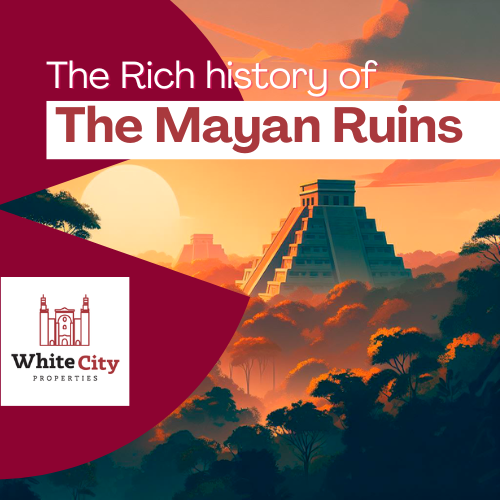The Rich History and Culture of Yucatán’s Mayan Ruins
July 25th, 2024

Yucatán, a region steeped in history and culture, is home to some of the most impressive Mayan ruins in the world. These ancient sites offer a fascinating glimpse into the lives and achievements of the Mayan civilization, which thrived in this area for centuries. In this blog, we’ll explore some of the most iconic and lesser-known Mayan ruins in Yucatán, providing insights into their history, significance, and what makes each site unique.
1. Chichén Itzá: The Jewel of Yucatán
Chichén Itzá is undoubtedly the most famous Mayan archaeological site in Yucatán and one of the New Seven Wonders of the World. Located in the northern part of the peninsula, this expansive site features a range of impressive structures, each with its own historical significance.
El Castillo (Temple of Kukulcán): This iconic pyramid is the centerpiece of Chichén Itzá. It is a testament to the Mayan’s advanced understanding of astronomy, as the pyramid aligns with the equinoxes, creating a shadow that resembles a serpent descending the steps.
The Great Ball Court: The largest and best-preserved ball court in ancient Mesoamerica, this structure was used for playing the Mesoamerican ballgame. The acoustics here are remarkable; a whisper from one end of the court can be heard clearly at the other end.
Cenote Sagrado: This sacred cenote was a site of pilgrimage and sacrifice for the Mayans. Archaeologists have found numerous artifacts and human remains at the bottom of this cenote, highlighting its religious importance.
2. Uxmal: The City of the Magician
Located in the Puuc region, Uxmal is known for its ornate architecture and unique structures. The city’s name means "thrice-built," reflecting its construction history.
Pyramid of the Magician: This pyramid stands out due to its rounded sides and steep steps. According to legend, it was built overnight by a dwarf with magical powers.
Nunnery Quadrangle: This impressive complex of four buildings surrounds a central courtyard. The intricate carvings and mosaic stonework on the buildings showcase the artistic prowess of the Mayans.
Governor’s Palace: This long, low building is adorned with detailed friezes depicting various Mayan deities and motifs. It is considered one of the finest examples of Puuc architecture.
3. Ek’ Balam: The Black Jaguar
Ek’ Balam, meaning "Black Jaguar," is a lesser-known site that offers a more tranquil experience compared to the more popular ruins. Located in the northern part of Yucatán, Ek’ Balam is known for its well-preserved structures and stunning stucco sculptures.
Acropolis: The largest structure at Ek’ Balam, this pyramid is notable for its intricate carvings and well-preserved stucco facade. Climbing to the top provides a breathtaking view of the surrounding jungle.
Ball Court: Like many Mayan cities, Ek’ Balam has a ball court used for the traditional Mesoamerican ballgame. The carvings on the ball court’s walls depict scenes of players and deities.
The Entrance Arch: This arch, located at the city’s entrance, is a beautiful example of Mayan architecture. It served as a ceremonial gateway into the city.
4. Kabah: The Mask City
Kabah is part of the Puuc route, known for its ornate buildings decorated with masks of the rain god Chaac.
Palace of the Masks: This structure is adorned with hundreds of stone masks of Chaac, the Mayan rain god. The repetition of these masks creates a striking visual effect.
Codz Poop: Meaning “Rolled Mat,” this building is one of the most elaborate in Kabah. The facade is covered in intricate carvings and statues, making it a remarkable example of Puuc architecture.
5. Sayil: The Place of Ants
Sayil is another significant site on the Puuc route, characterized by its large palaces and residential buildings.
Great Palace: This three-story structure is the most prominent building in Sayil. The palace features a series of rooms and courtyards, showcasing the city’s complex urban planning.
Mirador Temple: This temple offers a panoramic view of the surrounding area and is a great spot to appreciate the scale of the city.
Exploring the Mayan ruins of Yucatán is a journey through time, offering a glimpse into the rich history and culture of one of the most advanced civilizations of the ancient world. From the iconic pyramids of Chichén Itzá to the ornate facades of Uxmal and the tranquil beauty of Ek’ Balam, each site has its own unique story to tell. Whether you’re an avid history buff or a casual traveler, the Mayan ruins of Yucatán are sure to leave you in awe of their architectural genius and cultural significance.
Plan your visit today and immerse yourself in the fascinating world of the ancient Maya.


